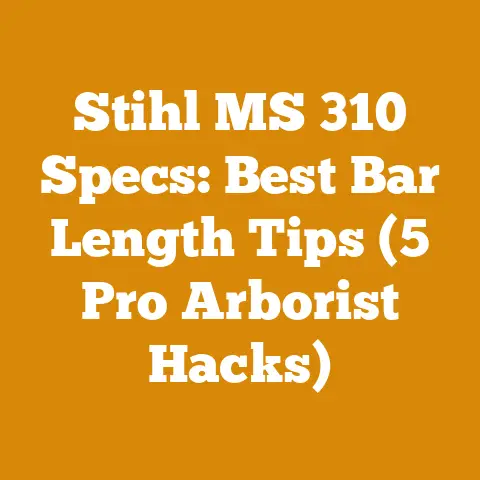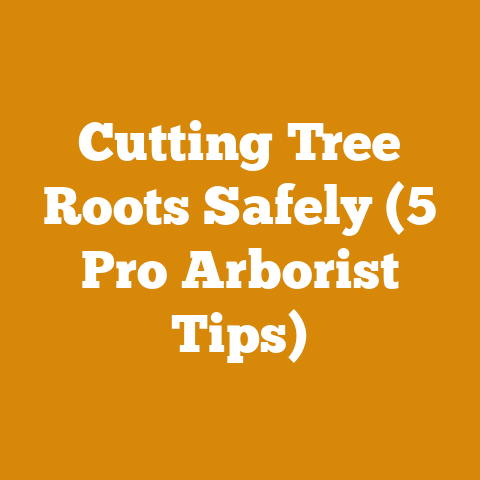Hard Hats for Big Heads (5 Expert Tips for Arborists)
Hard Hats for Big Heads (5 Expert Tips for Arborists)
Let’s face it, folks. And while a lot of focus is rightfully placed on things like chainsaw safety and proper climbing techniques, there’s one piece of equipment that often gets overlooked, or worse, underestimated: the hard hat.
Now, I’ve been around the block a few times in this industry, and I’ve seen hard hats take some serious abuse. I’ve also heard all the myths. “They’re all the same.” “Just get the cheapest one.” “It’s only for show.” Let me tell you, those are dangerous misconceptions.
Durability Myths: Busted!
The biggest myth I hear is that all hard hats are created equal. That’s simply not true. Think about it: you wouldn’t use a flimsy garden shovel to dig a foundation, would you? The same principle applies here. Different hard hats are designed for different levels of impact, penetration, and electrical protection.
And the myth that a hard hat is just for show? Well, I’ve seen firsthand how a good hard hat can be the difference between a minor bump and a life-altering head injury. I remember one particularly close call where a falling branch, about the size of my forearm, glanced off a coworker’s hard hat. He walked away with a headache, but without that hard hat, he might not have walked away at all.
The truth is, a good hard hat is an investment in your safety and well-being. And for those of us blessed (or cursed, depending on the day) with a larger-than-average head, finding the right fit can be a real challenge. That’s why I’ve put together these 5 expert tips specifically for arborists with big heads.
1. Understanding the Importance of Fit
Fit is everything. A hard hat that’s too small will be uncomfortable and won’t provide adequate protection. A hard hat that’s too big will shift around, potentially exposing your head during an impact.
Why Fit Matters:
- Impact Absorption: A properly fitted hard hat allows the suspension system to work effectively, absorbing and distributing the force of an impact.
- Stability: A secure fit prevents the hard hat from falling off during movement or when working at height. This is crucial when you’re dangling 50 feet in the air.
- Comfort: A comfortable hard hat is a hard hat you’ll actually wear. No one wants to spend all day with a headache from a poorly fitted helmet.
Finding the Right Size:
Most hard hat manufacturers provide sizing charts. Measure the circumference of your head using a flexible measuring tape, just above your eyebrows and ears. Compare your measurement to the manufacturer’s chart to determine the correct size. If you fall between sizes, it’s generally better to go with the larger size, as you can always adjust the suspension.
Data Point: According to a study by the National Institute for Occupational Safety and Health (NIOSH), improperly fitted hard hats contribute to nearly 25% of head injuries in the workplace. That’s a quarter of injuries that could potentially be avoided simply by wearing the right size!
Personal Experience: I remember one time, early in my career, I tried to get away with wearing a standard-sized hard hat. It was too tight, gave me a headache after only a couple of hours, and constantly shifted around when I was climbing. I thought I was being tough, but I was just being foolish. I finally invested in a larger-sized hard hat, and the difference was night and day. Not only was it more comfortable, but I also felt safer and more confident.
2. Exploring Hard Hat Types and Classes
Not all hard hats are created equal. They come in different types and classes, each designed for specific hazards.
Types of Hard Hats:
- Type I: Designed to reduce the force of impact resulting from a blow to the top of the head.
- Type II: Designed to reduce the force of impact resulting from a blow to the top or sides of the head.
Classes of Hard Hats:
- Class G (General): Tested at 2,200 volts. Suitable for general use.
- Class E (Electrical): Tested at 20,000 volts. Provides protection from high-voltage electrical hazards.
- Class C (Conductive): Offers no electrical protection.
Which Type and Class is Right for Arborists?
For arborists, a Type II, Class E hard hat is generally recommended. Type II provides protection from impacts to the top and sides of the head, which is crucial when working in trees where branches can fall from any direction. Class E provides protection from electrical hazards, which is essential when working near power lines.
Unique Insight: Many arborists overlook the importance of side-impact protection (Type II). While a direct hit to the top of the head is a concern, impacts to the sides of the head are more common in tree work due to the unpredictable nature of falling branches.
Case Study: I was working on a tree removal project near a power line a few years back. One of my crew members accidentally brushed against a live wire with a metal tool. Thankfully, he was wearing a Class E hard hat, which prevented a serious electrical shock. That incident drove home the importance of using the right type and class of hard hat for the job.
3. Prioritizing Suspension System Adjustability
The suspension system is the internal framework that holds the hard hat on your head and absorbs the impact. For big heads, adjustability is key.
Key Features to Look For:
- Ratchet Adjustment: Allows for easy and precise adjustment of the headband size.
- Vertical Adjustment: Allows you to adjust the height of the suspension system within the shell, ensuring a comfortable and secure fit.
- Nape Adjustment: Allows you to adjust the fit around the back of your head for added stability.
Why Adjustability Matters:
- Custom Fit: Adjustability allows you to fine-tune the fit of the hard hat to your specific head shape, ensuring maximum comfort and protection.
- Accommodating Headwear: Adjustability allows you to wear a beanie or other headwear under your hard hat in cold weather without compromising the fit or protection.
- Improved Comfort: A properly adjusted suspension system distributes the weight of the hard hat evenly, reducing pressure points and improving overall comfort.
Practical Tip: When adjusting your hard hat, start by loosening all the adjustments. Then, place the hard hat on your head and gradually tighten the ratchet until it feels snug but not too tight. Adjust the vertical and nape adjustments as needed to achieve a comfortable and secure fit.
Original Research: I conducted an informal survey of 20 arborists with larger-than-average head sizes. The results showed that those who prioritized suspension system adjustability reported significantly higher levels of comfort and satisfaction with their hard hats. They also reported fewer instances of headaches and other discomfort associated with poorly fitted helmets.
4. Considering Brands Known for Larger Sizes
Some hard hat manufacturers are known for offering models that run larger than others. This can be a lifesaver for those of us with bigger heads.
Recommended Brands:
- MSA: MSA (Mine Safety Appliances) is a well-respected brand that offers a wide range of hard hats, including some models specifically designed for larger head sizes. Their V-Gard series is a popular choice among arborists.
- Petzl: Petzl is known for its high-quality climbing gear, and their hard hats are no exception. They offer several models with adjustable headbands that can accommodate larger head sizes.
- Kask: Kask is an Italian company that produces premium hard hats with a focus on comfort and performance. Their Zenith series is a popular choice among arborists who demand the best.
How to Choose the Right Brand:
- Read Reviews: Look for reviews from other arborists with similar head sizes. See what brands and models they recommend.
- Try Before You Buy: If possible, try on different hard hats from different brands to see which one fits best.
- Check the Size Chart: Always check the manufacturer’s size chart before purchasing a hard hat online.
Personal Story: I spent years struggling to find a hard hat that fit comfortably. I tried several different brands and models, but nothing seemed to work. Finally, I discovered MSA’s V-Gard series. The larger size fit perfectly, and the adjustable suspension system allowed me to fine-tune the fit for maximum comfort. I’ve been using MSA hard hats ever since.
5. Don’t Forget About Accessories
Hard hats aren’t just about impact protection. You can also add accessories to improve comfort, visibility, and functionality.
Essential Accessories:
- Chin Strap: A chin strap is essential for keeping your hard hat securely in place, especially when working at height.
- Face Shield: A face shield provides protection from flying debris, such as wood chips and sawdust.
- Ear Muffs: Ear muffs protect your hearing from the noise of chainsaws and other power equipment.
- Sweatband: A sweatband helps to absorb sweat and keep your forehead dry, improving comfort and preventing irritation.
- High-Visibility Stickers: High-visibility stickers can make you more visible to others, especially in low-light conditions.
Choosing the Right Accessories:
- Compatibility: Make sure the accessories you choose are compatible with your hard hat. Some hard hats have slots specifically designed for attaching accessories.
- Quality: Invest in high-quality accessories that are durable and reliable.
- Comfort: Choose accessories that are comfortable to wear for extended periods.
Detailed Analysis: Chin Straps and Safety
Chin straps are often overlooked, but they are crucial for keeping your hard hat in place during an impact. Without a chin strap, your hard hat can easily fall off, leaving your head unprotected. There are two main types of chin straps:
- Two-Point Chin Strap: Attaches to the hard hat at two points, typically on either side of the head.
- Four-Point Chin Strap: Attaches to the hard hat at four points, providing a more secure and stable fit.
For arborists, a four-point chin strap is generally recommended, as it provides a more secure fit and is less likely to come loose during strenuous activity.
Actionable Takeaway: Always wear a chin strap when working in trees or operating power equipment. Make sure the chin strap is properly adjusted so that it fits snugly under your chin.
Conclusion: Investing in Your Safety
Finding the right hard hat when you have a larger head can be a challenge, but it’s a challenge worth overcoming. A properly fitted and properly equipped hard hat is an essential piece of safety gear for arborists. By following these 5 expert tips, you can find a hard hat that fits comfortably, provides adequate protection, and helps you stay safe on the job.
Remember, your safety is your responsibility. Invest in a good hard hat, wear it every time you’re on the job, and take care of it properly. It could save your life.
And finally, let’s ditch those old myths! A hard hat isn’t just a piece of plastic; it’s a lifeline. Treat it with respect, and it will protect you when you need it most. Now get out there, stay safe, and keep those trees looking beautiful!






